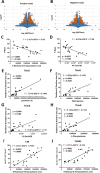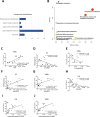Rat Hair Metabolomics Analysis Reveals Perturbations of Unsaturated Fatty Acid Biosynthesis, Phenylalanine, and Arachidonic Acid Metabolism Pathways Are Associated with Amyloid-β-Induced Cognitive Deficits
- PMID: 37095368
- PMCID: PMC10293421
- DOI: 10.1007/s12035-023-03343-6
Rat Hair Metabolomics Analysis Reveals Perturbations of Unsaturated Fatty Acid Biosynthesis, Phenylalanine, and Arachidonic Acid Metabolism Pathways Are Associated with Amyloid-β-Induced Cognitive Deficits
Abstract
Hair is a noninvasive valuable biospecimen for the long-term assessment of endogenous metabolic disturbance. Whether the hair is suitable for identifying biomarkers of the Alzheimer's disease (AD) process remains unknown. We aim to investigate the metabolism changes in hair after β-amyloid (Aβ1-42) exposure in rats using ultra-high-performance liquid chromatography-high-resolution mass spectrometry-based untargeted and targeted methods. Thirty-five days after Aβ1-42 induction, rats displayed significant cognitive deficits, and forty metabolites were changed, of which twenty belonged to three perturbed pathways: (1) phenylalanine metabolism and phenylalanine, tyrosine, and tryptophan biosynthesis-L-phenylalanine, phenylpyruvate, ortho-hydroxyphenylacetic acid, and phenyllactic acid are up-regulated; (2) arachidonic acid (ARA) metabolism-leukotriene B4 (LTB4), arachidonyl carnitine, and 5(S)-HPETE are upregulation, but ARA, 14,15-DiHETrE, 5(S)-HETE, and PGB2 are opposite; and (3) unsaturated fatty acid biosynthesis- eicosapentaenoic acid (EPA), docosahexaenoic acid (DHA), FA 18:3 + 1O, and FA 18:3 + 2O are downregulated. Linoleic acid metabolism belonging to the biosynthesis of unsaturated fatty acid includes the upregulation of 8-hydroxy-9,10-epoxystearic acid, 13-oxoODE, and FA 18:2 + 4O, and downregulation of 9(S)-HPODE and dihomo-γ-linolenic acid. In addition, cortisone and dehydroepiandrosterone belonging to steroid hormone biosynthesis are upregulated. These three perturbed metabolic pathways also correlate with cognitive impairment after Aβ1-42 stimulation. Furthermore, ARA, DHA, EPA, L-phenylalanine, and cortisone have been previously implicated in the cerebrospinal fluid of AD patients and show a similar changing trend in Aβ1-42 rats' hair. These data suggest hair can be a useful biospecimen that well reflects the expression of non-polar molecules under Aβ1-42 stimulation, and the five metabolites have the potential to serve as novel AD biomarkers.
Keywords: Arachidonic acid; Hair metabolism; L-Phenylalanine; Targeted/untargeted metabolomics; Unsaturated fatty acid.
© 2023. The Author(s).
Conflict of interest statement
The authors declare no competing interests.
Figures






Similar articles
-
Characterization of Hair Metabolome in 5xFAD Mice and Patients with Alzheimer's Disease Using Mass Spectrometry-Based Metabolomics.ACS Chem Neurosci. 2024 Feb 7;15(3):527-538. doi: 10.1021/acschemneuro.3c00587. Epub 2024 Jan 25. ACS Chem Neurosci. 2024. PMID: 38269400 Free PMC article.
-
Correlation between immune-related Tryptophan-Kynurenine pathway and severity of severe pneumonia and inflammation-related polyunsaturated fatty acids.Immun Inflamm Dis. 2023 Nov;11(11):e1088. doi: 10.1002/iid3.1088. Immun Inflamm Dis. 2023. PMID: 38018595 Free PMC article.
-
UHPLC-QTOF/MS-based metabolomics investigation for the protective mechanism of Danshen in Alzheimer's disease cell model induced by Aβ1-42.Metabolomics. 2019 Jan 17;15(2):13. doi: 10.1007/s11306-019-1473-x. Metabolomics. 2019. PMID: 30830431
-
Long-chain polyunsaturated fatty acids (LCPUFA) from genesis to senescence: the influence of LCPUFA on neural development, aging, and neurodegeneration.Prog Lipid Res. 2014 Jan;53:1-17. doi: 10.1016/j.plipres.2013.10.002. Epub 2013 Oct 24. Prog Lipid Res. 2014. PMID: 24334113 Review.
-
Lipidomic profiling of bioactive lipids by mass spectrometry during microbial infections.Semin Immunol. 2013 Oct 31;25(3):240-8. doi: 10.1016/j.smim.2013.08.006. Epub 2013 Sep 29. Semin Immunol. 2013. PMID: 24084369 Free PMC article. Review.
Cited by
-
Metabolomic analysis of rat arterial serum under hypobaric hypoxia: Adaptive regulation of physiological systems by metabolic reprogramming.Biochem Biophys Rep. 2025 Feb 18;41:101943. doi: 10.1016/j.bbrep.2025.101943. eCollection 2025 Mar. Biochem Biophys Rep. 2025. PMID: 40041253 Free PMC article.
-
Polystyrene Accelerates Aging Related-Gut Microbiome Dysbiosis and -Metabolites in Old-Aged Mouse.J Microbiol Biotechnol. 2025 Aug 7;35:e2504016. doi: 10.4014/jmb.2504.04016. J Microbiol Biotechnol. 2025. PMID: 40774819 Free PMC article.
-
Untargeted and Oxylipin-Targeted Metabolomics Study on the Plasma Samples of Primary Open-Angle Glaucoma Patients.Biomolecules. 2024 Mar 5;14(3):307. doi: 10.3390/biom14030307. Biomolecules. 2024. PMID: 38540727 Free PMC article.
-
Large Unilamellar Vesicles of Phosphatidic Acid Reduce the Toxicity of α-Synuclein Fibrils.Mol Pharm. 2024 Mar 4;21(3):1334-1341. doi: 10.1021/acs.molpharmaceut.3c01012. Epub 2024 Feb 19. Mol Pharm. 2024. PMID: 38373398 Free PMC article.
-
Characterization of Hair Metabolome in 5xFAD Mice and Patients with Alzheimer's Disease Using Mass Spectrometry-Based Metabolomics.ACS Chem Neurosci. 2024 Feb 7;15(3):527-538. doi: 10.1021/acschemneuro.3c00587. Epub 2024 Jan 25. ACS Chem Neurosci. 2024. PMID: 38269400 Free PMC article.
References
MeSH terms
Substances
Grants and funding
LinkOut - more resources
Full Text Sources
Medical
Research Materials

